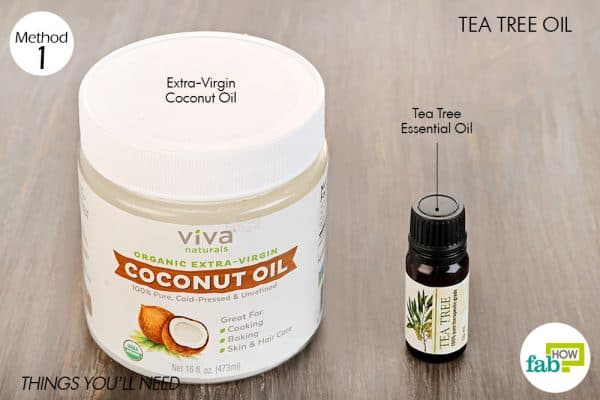Angular cheilitis, also known as perlèche refers to an area of inflammation occurring at the angles of the mouth that often involves a fungal infection. This chronic, reoccurring condition can affect either one side or both sides of the mouth. (1)
The condition starts as mild discomfort & burning at the corners of the mouth, that can slowly progress into painful sores. (1)
While the inflammation may not appear very grave, it can make everyday activities like speaking and eating difficult.

Before we look at home remedies for treating angular cheilitis, read on to learn what causes it and what symptoms you should look out for.
Contents
Causes of Angular Cheilitis
The primary cause of angular cheilitis is the accumulation of saliva in the corners of the mouth which creates a moist environment supporting yeast growth.
This can be due to mechanical irritation (i.e., drooling, intertrigo), infections (i.e., candidiasis), nutritional deficiency (i.e., iron, riboflavin), or contact dermatitis.
More common in the elderly-with aging, sagging facial contours, dentures, and/or shortening of the lower facial area due to loss of teeth, create skin folds at the angles of the mouth predisposing to maceration, cracking, and secondary yeast (i.e. candida) infection. (2)
Other causes or contributing factors include:
- Excessive licking of lips, which creates a moist environment for the yeast to grow.
- Bacterial or viral infection.
- Persistent oral thrush.
- Excessive use of antibiotics.
- Crohn’s disease.
- Ill-fitted dentures.
- Nutritional deficiency (i.e. iron, zinc or vitamin B2)
- Overhanging upper lip.
- Conditions like diabetes, anemia or cancer can also make you prone to angular cheilitis.
Symptoms of Angular Cheilitis
Apart from irritation and dryness in the corners of the mouth, angular cheilitis can also cause:
- Red inflamed, cracked, and eroded skin folds at the angles of the mouth
- Painful and bleeding lips
- Red, swollen, & cracked corners of the
- Itchy, cracked and crusty skin on the
- Pustules, which are spots resembling blisters or
- Bad taste in the
Preventing Angular Cheilitis
Some tips to prevent angular cheilitis include. (2)
- Avoid licking or biting your
- Drink enough water to keep yourself hydrated and prevent dry or chapped lips.
- Keep your skin and lips well-moisturized.
- Use of a lip balm such as ChapStick several times daily, applying to lips and angles of the mouth
- Maintain good oral hygiene
- Improve dentures and/or dentation
- Avoid using harsh
Home Remedies to Treat Angular Cheilitis
If you are suffering from symptoms of angular cheilitis, it is important to get the condition diagnosed to ensure appropriate treatment. Your doctor may take culture swabs from the corners of your mouth to send to a lab for testing.
Once confirmed, you can use one of the following home remedies to get rid of angular cheilitis.
Method 1: Tea Tree Oil
Tea tree oil is the most popular remedy for treating any fungal infection. The volatile oil, when diluted and applied topically, not only works as an antiseptic but also has an anti-inflammatory effect on the skin, and is especially useful for treating acne. (3)
When using tea tree oil, dilute it in coconut oil first. Coconut oil also is a natural antifungal and will further help soothe the skin by keeping it moisturized, too.
Things you’ll need:
- Tea tree essential oil (antifungal) – 2 or 3 drops
- Extra-virgin coconut oil (antifungal and used as a carrier oil) – 1 tablespoon
Single-Step Treatment: Dilute tea tree oil in coconut oil and apply

- Add 2 or 3 drops of tea tree essential oil to 1 tablespoon of extra-virgin coconut oil.
- Blend the two oils.
- Soak a cotton ball in the solution.
- Dab it over the affected skin surrounding your mouth.
Reapply it 3 times daily for 2 to 3 days to get rid of angular cheilitis.
Method 2: Vitamin B
Our bodies require vitamin B to strengthen the immune system and ward off infections. Sometimes, people deficient in B vitamins can also develop mouth sores or angular cheilitis because the body fails to keep the candida yeast in check. (1)
The incidence of angular cheilitis or stomatitis is higher in individuals with low riboflavin (vitamin B2) concentration.
Increasing the level of this vitamin in your body will not only aid swift recovery from the infection but also improve your overall health. (4)
Single-Step Treatment: Consume vitamin B complex
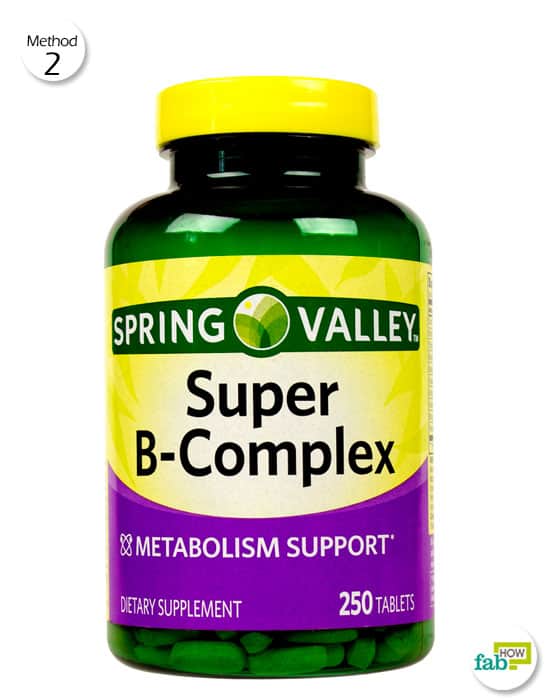
- Consume 1 vitamin B complex capsule every day for 3 to 4 days to treat angular cheilitis. You will notice an improvement in just 24 hours. Continue to take the supplement for 1 week to improve your body’s resistance.
- Once the infection has completely healed, whenever symptoms seem to flare up, simply take a vitamin B capsule to nip it in the bud.
Method 3: Dish Soap & Vaseline
This folk remedy to treat angular cheilitis uses dish soap, which acts as a mild antibacterial cleanser to disinfect the skin. Also, fungi thrive in a moist environment and Vaseline helps kill it by forming a waterproof layer over the pathogenic cells.
In fact, you can also use Vaseline to heal minor wounds quickly, and to stop bleeding from cuts and wounds.
Things you’ll need:
- Warm water – ½ cup
- Vaseline (waterproofs skin)
- Liquid dish soap (antibacterial cleanser) – 1 teaspoon
Step 1. Clean the affected area with diluted dish soap
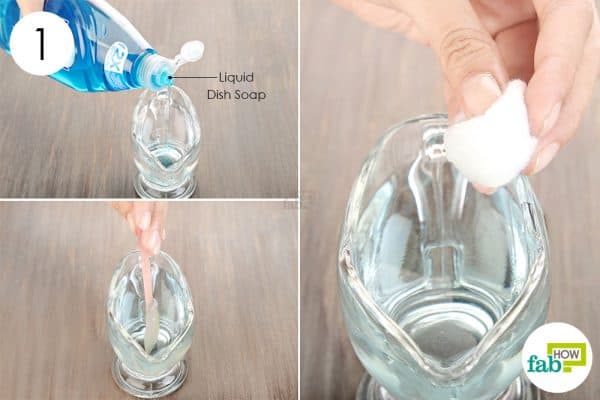
- Add about 1 teaspoon of liquid dish soap to ½ cup of warm water.
- Mix well to dissolve the soap.
- Soak a cotton ball in the solution and swipe it over the affected skin to clean off any dirt or impurities.
- Pat dry the skin with a clean cloth.
Step 2. Apply Vaseline over the affected skin
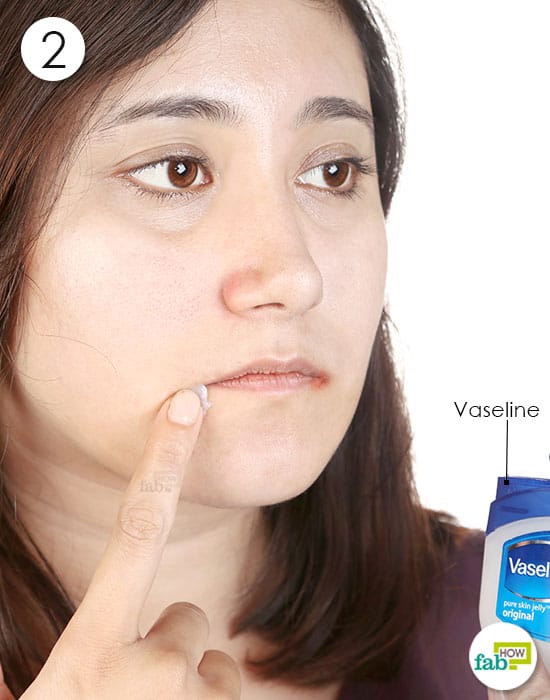
- Coat the inflamed skin with a thick layer of Vaseline.
Repeat every 2 hours for 3 to 4 days to heal angular cheilitis completely.
Method 4: Yogurt
Yogurt that contains live cultures of Lactobacillus bacteria, or the healthy bacteria, will help decolonize the invading pathogens and restore the natural flora in your body. (5)
Apart from consuming probiotic yogurt, applying it topically can also help get rid of angular cheilitis.
When using yogurt to treat an infection, opt for unsweetened and unflavored varieties only.
Single-Step Treatment: Apply plain yogurt on the inflamed skin
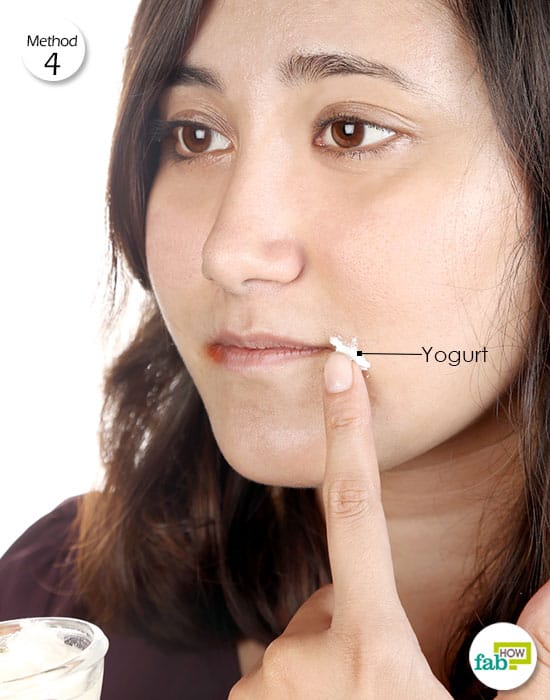
- Apply plain yogurt containing live cultures on the corners of your mouth.
- Leave it on overnight.
- The next morning, rinse it off with lukewarm water, pat dry and reapply.
Apply plain yogurt daily. You will notice improvement after the very first night. Continue for up to 1 week to get rid of angular cheilitis naturally.
Method 5: Manuka Honey
Produced in New Zealand, Manuka honey has been used in medicine for hundreds of years and is being embraced as an amazing healing potion all around the world.
In addition to its known antiseptic properties, containing over 200 types of microbes, Manuka honey also contains amino acids, enzymes, & a plethora of vitamins & minerals, including B-vitamins.
Compared to normal honey, Manuka Honey is the most nutrient-dense of all types of honey, containing four times that of normal honey of vitamins, nutrients & enzymes, especially in terms of its antibacterial agents. (6)
While common honey works by releasing hydrogen peroxide to heal wounds, Manuka honey contains a compound called methylglyoxal that gives it superior antimicrobial properties, used to treat conditions like acne inversa and perioral dermatitis.
Note: Make sure you are buying genuine Manuka Honey that originates from and is "Packed & Labeled" in New Zealand, where they have very strict very strict Manuka Honey Labeling laws. Also, it is best to check the MGO level as well to be safe.
Single-Step Treatment: Apply Manuka honey on the blistered ski

- Apply Manuka honey over the cracked and blistered skin.
- Leave it on for 2 to 3 hours, then rinse it off with tepid water.
- Pat dry your skin and reapply.
Apply Manuka honey several times a day to cure angular cheilitis.
Method 6: Antifungal Cream
If none of the natural ingredients above have helped you, consult your doctor about using antifungal cream. These over-the-counter creams contain 0.5 to 1% hydrocortisone, a mild steroid that helps bring down the inflammation significantly. (7)
Single-Step Treatment: Apply antifungal cream on the inflamed skin

- Apply 1% hydrocortisone-based antifungal cream on the inflamed or cracked skin several times a day to get rid of angular cheilitis.
Tips to keep in mind
- Cleaning pus-filled lesions with Listerine will make them dry out faster.
- Curb or reduce your consumption of sugar and bread, as bacteria feed on carbohydrates.
- Eat probiotic yogurt on a daily basis to maintain healthy gut flora.
- Consume more fibrous foods and increase your water intake.
- Keep your lips hydrated using a homemade lip balm.
- Keep your home warm during extreme cold to prevent dry skin and flare-ups.
Resources:
- Gharbi A. Cheilitis. StatPearls [Internet]. https://www.ncbi.nlm.nih.gov/books/NBK470592/. Published January 27, 2019.
- Federico JR. Angular Cheilitis. StatPearls [Internet]. https://www.ncbi.nlm.nih.gov/books/NBK536929/. Published January 8, 2019.
- Patil S, Rao RS, Majumdar B, Anil S. Clinical Appearance of Oral Candida Infection and Therapeutic Strategies. Frontiers in microbiology. https://www.ncbi.nlm.nih.gov/pmc/articles/PMC4681845/. Published December 17, 2015.
- Hugar SM. (PDF) Assessment of Vitamin B 12 and Its Correlation with ... International Journal of Clinical Pediatric Dentistry. https://www.researchgate.net/publication/317304085. Published 2017.
- Mailänder-Sánchez D, Wagener J, Schaller M. Potential role of probiotic bacteria in the treatment and prevention of localised candidosis. Mycoses. https://www.ncbi.nlm.nih.gov/pubmed/21672043. Published January 2012.
- D G. Honey Antibacterial Activity. OMICS International. https://www.omicsonline.org/open-access/honey-antibacterial-activity-2167-0412.1000152.php?aid=23653. Published February 24, 2014.
- Collins CD, Cookinham S, Smith J. Management of oropharyngeal candidiasis with localized oral miconazole therapy: efficacy, safety, and patient acceptability. Patient preference and adherence. https://www.ncbi.nlm.nih.gov/pmc/articles/PMC3150165/. Published 2011.


